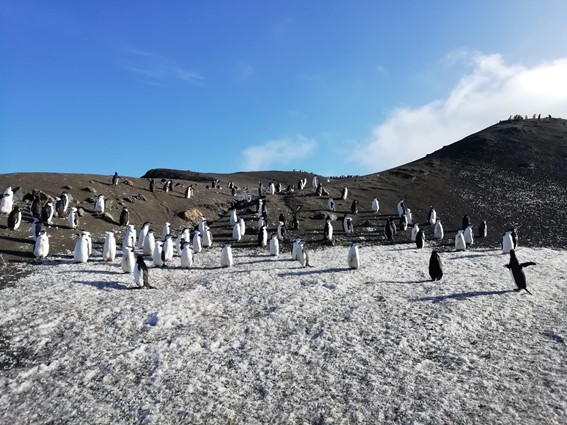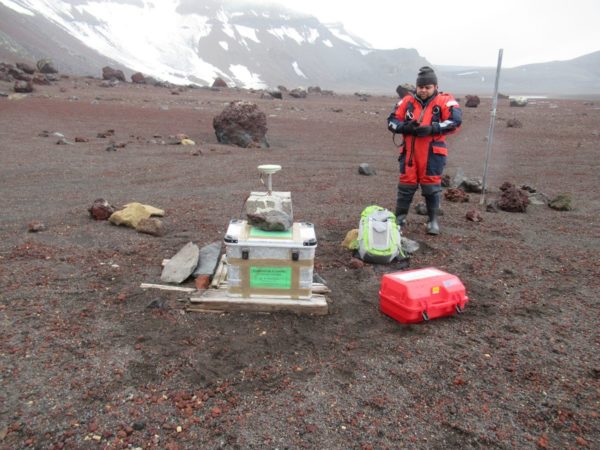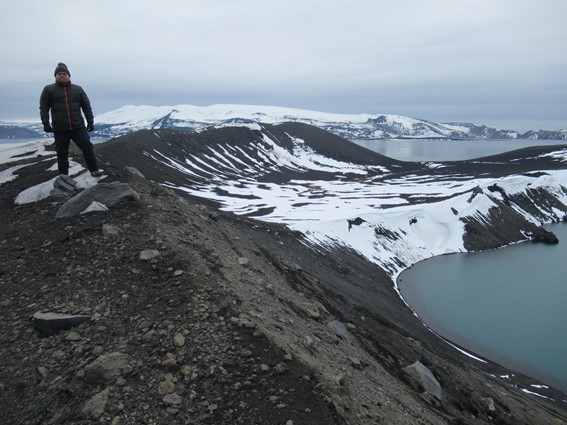A Nicaraguan on a Scientific Mission in Antarctica

As a child he used to collect computer parts in the “La Chureca” garbage dump. Today he participates with a Spanish mission in search of geodynamic data in the South Pole.
By Cindy Regidor (Confidencial)
HAVANA TIMES – Javier Ramirez had only seen penguins on television. That changed at 34 years old, on January 24, 2021, when he arrived on Deception Island, in Antarctica. Upon landing on the icy continent, he saw the penguins who would be the group´s hosts. An image, which added to the sensation of -12 degree Celsius of ambient temperature, he will never forget.
Ramírez is the first Nicaraguan at the “Gabriel de Castilla” Base, one of the two Spanish bases located on Deception Island in the South Shetland Islands Archipelago, in Antarctica. There he saw some Spanish military officers placed the Nicaraguan flag on the pole, along with that of Spain. A gesture that surprised him and filled him with pride, he told Confidencial a few days before concluding what would be one of the most exciting episodes of his life: one month in Antarctica as a scientific researcher.
Ramirez was part of the XXXIV Spanish Antarctica Campaign along with 17 other people, including soldiers and scientists. The mission, scheduled annually during the summer season in that area of the world, was coordinated by Dr. Manuel Berrocoso Dominguez. He has visited the continent since the first campaigns and is the director of the Astronomy Laboratory of the University of Cadiz, of Spain. It is there that the Nicaraguan is doing his doctorate in computer engineering.

During the four weeks he and his colleagues installed devices and collecting data from the volcanic island for different projects. Ramirez dedicated himself to the geodetic and geodynamic part of the island, thermometry, and oceanography. Others studied the permafrost, the frozen soils and climate change. Some analyzed the fauna of the site.
There was no rest during those days of hard work, nor monotony, Ramirez assured. “One day you go to a station, another you install a GPS and then you have to process data, then install a communication system to send the data. Maybe on another day you must go up to the penguin colony to install a thermal sensor. I didn’t rest even on Saturday or Sunday,” he described. During his stay, he even gave a talk about seismic and volcanic activity in Nicaragua.
The long journey to get there
The journey of the group of scientists was long and exhausting, especially on this occasion that they had to overcome the difficulties imposed by the coronavirus pandemic. That’s why the visit that usually lasts three or four months, this time was only of one month.
Ramirez lives in Puerto Real, in the city in Cadiz. The journey stated when he drove his car to Madrid. There he took a transatlantic flight that took him to Santiago de Chile, where he took another flight that took him to the southern tip of the country and the interoceanic port of Punta Arenas, in the province of Magallanes.
There the group had to be confined for 15 fifteen days in a hotel, amid the fear that some of them would test positive for Covid-19, because this would imply the cancellation of the campaign. They took the test, and the results were negative, so they continued the trip. This time aboard the Sarmiento de Gamboa Oceanographic Ship for almost seven days.
“Sailing was extremely hard because we passed through the Drake passage or Sea of Hoces. There the waters are very violent, and the truth is that you go through hell. It was a tough experience,” he recalled.
Finally, they arrived at Deception Island, disembarked, and were transferred to the shores in boats already wearing special survival suits for these adverse weather circumstances. If a person falls into the water without such a suit, they can die of hypothermia in five minutes, he explained. They stepped onto the ground and went to the Gabriel de Castilla Base, managed by the Spanish Army.

Life at the base
The military base is designed to receive research teams: it has several “life modules,” such as a gym, a small clinic run by a doctor, several warehouses, including one with all the necessary food for the team during the 30 days.
“The water we consume comes from a volcanic crater, from a lagoon called “Zapatilla” Island. There is a heating system and a purification system to be able to use the water and they do analysis every so often,” he explained. The energy comes from fuel engines that supply and make the base comfortable in the middle of the inhospitable island.
Outside the base, the deserted island was extremely cold and dark, with only a few hours of sunshine and extremely changeable weather, heavy blizzards that left everything covered in snow from time to time.
Under these conditions, Ramirez would go out to do his work, sometimes in special vehicles that moved them to different areas. Sometimes on foot carrying specialized equipment that he had to install. Sometimes he could not go out at all, due to the sudden weather changes and strong winds.
Penguins, seals, and sea lions were also part of the landscape. It is forbidden to approach the animals, but some approached them, curious to see the researchers at work. “If the penguins come close, that is something else. But you cannot get close to them, you must be ten meters away. Some chased me, but they are not dangerous. The ones that are a little more dangerous are the sea lions that can scare you. They chase you and have good speed, but you have to get away from them,” he recalled.

“The truth is that I haven’t missed a thing. I have felt very good. I have learned many things,” he said from the base. And was thankful for the warm welcome he felt from the team in which all were Spaniards, except him.
It was an experience that marked his life. “Not everyone comes to Antarctica. You cannot catch any commercial flight to go to Antarctica. You have to be within the scientific community, be selected,” he said proudly.
“I take with me the hard work, the marvelous and impressive landscapes, a lagoon’s crater, the sight of “Puerto Foster,” the fumaroles, the contrast of the black volcanic sediments with the whiteness of the snow, to see the whole landscape in 360 degrees and you feel that you are…well, like at the end of the world,” he added.

A passion for geodynamics
But how did this Nicaraguan get to be part of this mission? Ramirez graduated from the National University of Engineering (UNI) as a computer engineer and worked for almost nine years at the Nicaraguan Institute for Territorial Studies (INETER) as head of data processing of the Geology and Geophysics Department and the Seismology Department.
He started going to the field as an assistant of the maintenance technicians of the seismic network and thus began to become passionate about seismic and volcanic studies in a country like Nicaragua, with a great interaction of tectonic plates. A highly dangerous volcanic mountain range, and with “a very complicated meteorology,” he described.
“I am a seismologist and vulcanologist at heart,” he said, recalling how he entered those fields of study as he participated in workshops in Japan, Mexico, Switzerland, Colombia, Puerto Rico and mingled with foreign experts who came to the country. He also found that the purpose of these disciplines was noble. To save human lives by producing information that would contribute to making better evacuation and prevention decisions.
The young man repaired the specialized equipment, gave maintenance to procurement, monitoring and analysis systems. He was even in charge of the installation of the geodesic network at Concepcion Volcano on Ometepe Island.
Scientists from the University of Cadiz came to Nicaragua to observe the geodynamic deformation of the volcano and after working with him they proposed that he study a course of a couple of months on GPS technology at that university. That is how he met Dr. Berrocoso and began a very close relationship.
“I see him as a father,” he said. The Spanish researcher encouraged him to study a postgraduate degree, then a master’s degree in research in Systems Engineering and just a month after presenting his thesis, told him that he should continue with a doctorate, of which he is currently studying the third year.
“You have to be hungry”
He did all those studies with scholarships. The opportunities came because “hunger” was noticeable, he reflected. “What they saw in me was a desire to excel. You must always be hungry. Professional hunger. Hunger to improve. I never imagined having a master’s degree in Spain. I hadn’t even imagined traveling, getting on a plane. However, when you have so many desires to excel, and feel the need to reach the top, you face the challenges despite all the obstacles,” he commented.
That hunger was present since his childhood, as were the challenges. Ramirez grew up in Acahualinca, in Managua, a poor neighborhood on the shores of Lake Managua near the “La Chureca” garbage dump. His mother was a teacher in a public school and his stepfather worked as a security guard. The salaries gave only just for his sustenance and that of his younger brother.
From the “life module” of Antarctica, the young scientist recalled the moment when he fell in love with computers. When an uncle brought a very old computer that he bought “on payments,” the kind that still used the MS-DOS system.

Later, as a teenager in high school, he realized his tremendous ability in that field. To help at home with a little extra money for food, Ramirez offered basic computer maintenance and with his friends from the neighborhood he started a successful business. They collected pieces in “La Chureca,” to later repair and sell, the computers and equipment that the garbage trucks came to discard. It all ended when the truck drivers realized the value of the parts and took them over to sell to their own customers.
The road has not been easy. He also recalled when at the university he sometimes didn’t have the five pesos to take the 102 bus route to and from the university. But “hunger” was always present and it continues to be there. He said that after the doctorate he would like to do a post doctorate in Switzerland. “If you work in science, you cannot stop studying, you don’t have to be conformist,” he reflected.
From the cold of Antarctica, Ramirez said that he misses his family that is still in Nicaragua. His wife and son live in the hot Managua, awaiting his return. The four-year-old child has asked him to bring him a penguin. “I already told him it is forbidden,” he said laughing.





